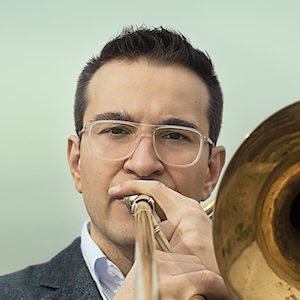
A technical routine for trombonists
All brass players have to incorporate a technical routine into their daily practise in order to maintain themselves at peak fitness. This persistence means that, little by little, they increase their facility on their respective instruments.
A daily routine has various objectives as far as I understand it:
the first of these being to warm up at the beginning of a day of productive practise minimising the risk of injury.
the second is to repeat and assimilate progressively the techniques necessary for playing the trombone. This second objective feels to me like starting again at the beginning of each new day, aiming to complete a puzzle, locating each piece in its place. This way I gradually progress searching for the physical sensations best suited to me. I try, over the passage of time, to fit all these pieces together smoothly with each other, whilst expanding the scale of the puzzle and thus developing my abilities. Every individual should design their own personal puzzle through their own experience and implement exercises which allow them to develop to their máximum potential.
During my own routine I try to reproduce physical sensations which allow me to play freely, using my perception as a guide. I continue my daily search for this ease of natural expression through routines which continue to challenge me, and sooner or later I achieve it. I find it very difficult to sum up the physical sensations I experience in a given exercise verbally, but I can atleast communicate my ideas linguistically. Later every musician has to search for their own sensations.
For me “technique” is simply the tool we employ in order to express our musical ideas. If it’s difficult for me to verbalise sensations when practising technical routines, I can’t begin to imagine how I would put the feelings I experience when making music into words, although this could be the subject of a future entry in this blog. Continuing for now with good technique, it is indispensable and necessary when we seek to raise our powers of interpretation to a professional level. If we think of an equation between the variables “music” and “technique”, the second is very much at the service of the first. Although I don’t consider a perfect technique essential for making music, I do believe that a good technique helps any young musician evolve effectively, and that it is absolutely necessary to become a good professional.
In line with my analogy of an equation between mathematics and music, my technical routine would effectively be a tribute to the number 3:
- Three blocks of work:
- Air
- Flexibility
- Articulation
2. Three aspects to be aware of:
- Sound quality
- Rhythm
- Intonation
3. Three elements to coordinate:
- Air
- Tongue
- Slide
Many young students mistakenly believe that the exercises themselves are the most important element when concocting a routine. From my point of view, however, exercises have an key function because they help us discover the correct physical sensations when playing. On the other hand, the manner in which we realise them is even more critical. It’s far more important the “how” than the “what”, and to understand the application of “how” to any given repertoire or situation. This is an essential part of working hand in hand with the student and it leads to the most productive period of study possible.
We will be tackling further technical questions in our upcoming blog entries and we will be delving deeper into the curious rule of 3. If anyone amongst you wants to know more about any of these subjects, and would like to work in person with our team at the Brass Academy Alicante, we would be more than happy to advise you. Furthermore we have now added distance learning to our existing intensive weekend teaching in a variety of formats and modules.
Hoping to meet you soon!
Daniel Perpiñan



